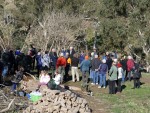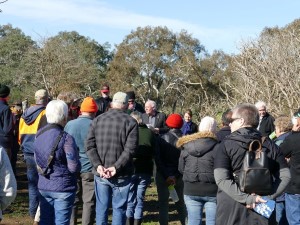 Launch of Werribee River biodiversity brochure
Launch of Werribee River biodiversity brochure
On Saturday 2nd June Pinkerton Landcare and Environment Group (PLEG) and Western Water welcomed the community to an Open Day to visit the Werribee River Volcanic Gorge beside Western Water’s treatment plant at Surbiton Park. PLEG launched their brochure ‘Restoration of the Werribee River Volcanic Gorge’ funded by a City of Melton World Environment Day Grant.
Open Day at Surbiton Park
Launch of Werribee River biodiversity brochure
On Saturday 2nd June Pinkerton Landcare and Environment Group (PLEG) and Western Water welcomed the community to an Open Day to visit the Werribee River Volcanic Gorge beside Western Water’s treatment plant at Surbiton Park. PLEG launched their brochure ‘Restoration of the Werribee River Volcanic Gorge’ funded by a City of Melton World Environment Day Grant.
 Visitors explored the stunningly beautiful volcanic gorge and learned about the four distinct ecological vegetation niches which are being restored, and the fauna which depend on them. This restoration project is supported by Port Phillip & Westernport Catchment Management Authority, Western Water, Melbourne Water, PLEG & BirdLife Australia (Werribee branch).
Visitors explored the stunningly beautiful volcanic gorge and learned about the four distinct ecological vegetation niches which are being restored, and the fauna which depend on them. This restoration project is supported by Port Phillip & Westernport Catchment Management Authority, Western Water, Melbourne Water, PLEG & BirdLife Australia (Werribee branch).
The Werribee River Volcanic Gorge has been classified by the National Trust landscape “… Those parts of the physical environment, both natural and man-made, which in the Trust’s view are essential to the heritage of Australia and which must be preserved”
The current grant from the Port Philip & Westernport Catchment Management Authority (2017/18) is for restoring the native grassland areas above the river gorge. The four different sections of native vegetation in the volcanic gorge were described according to topography. The participants were shown by Frances an example of a successful restoration of native grassland from a previous grant, and the methodology was explained. Self- sown Small-leaved clematis plants are now successfully growing within the grassland.
The Landcare Walk included practical examples of restoration of the four ecological classes on the magnificent Werribee River volcanic gorge. Walk participants learnt about the native wildlife and rare plant species which depend upon these niche ecosystems from the Landcare members who have been restoring this site since 2011 with the support of Western Water, Port Phillip & Westernport Catchment Management Authority, Melbourne Water and last but not least the broader community who have been seed collecting, propagating, monitoring (incl. Bird Life Australia, Werribee branch), weeding, planting and holding community activities such as walks, picnics (including the Pinkerton family picnic held last year), monitoring platypus, encouraging local school children and just simply having fun.
The educational leaflet was produced by PLEG members to provide a focus on the four ecological vegetation classes in the volcanic gorge, the native grasslands above, the steep rocky escarpments, the flood plain and stream bank. Each has their own suite of indigenous plants which have evolved over millions of years. And, similarly the animals have evolved with them, each complementing the other, which are also described.
As we restore each of these niches, removing rabbits and weeds, allowing the native species to thrive, we have become conscious of the fact that if we need to plant for the first time in a particular ecological niche, that we need to keep the balance of species proportionate to those already found on the site. This is the reason we have provided the detail of percentage of plant species present in each ecological vegetation class, so that our restoration actions ensure that one species doesn’t dominate another, thus providing an optimal habitat.
A total of 54 visitors including Melton councilors, environmentalists, conservationists, sporting shooters and several children, took advantage of the sunny day.
PLEG members described:
- restoration of native grasslands
- fauna & flora
- Wurundjeri archaeological artefacts
- eDNA sampling of platypus
- rare plant species found in the gorge
- monitoring of fauna and flora
Visitors were welcomed by PLEG President, Richard Rowe
At the top of the escarpment local native grassland landowners Frances Overmars and Simon Jolly described the restoration of the Low Rainfall Plains Grassland (EVC 132-63) on the Yaloak Escarpment. Frances is also PLEG Restoration Co-ordinator. From the Yaloak Escarpment we had a panoramic view over the magnificent volcanic gorge through which the Werribee River flows.
Local native grassland landowner Simon Jolly talked about the edible native tubers and how they were used successfully by indigenous people. Simon showed several of these tubers which he had grown,. These included Yam Daisy and Blue Grass-lily tubers, which were handed around for participants to see at close quarters.
The Kurungjang-balug clan of the Wurundjeri tribe previously lived in this region east of the Werribee River. To the west of the Werribee River lived the Wathaurong people. This site is named Yaloak Escarpment as the original name for this site by the local Kurunjang baluk people was apparently Woady Yaloak. This name was then adopted by the Pinkerton family when they settled here. Although the name Woady Yalloak is thought to refer to the large permanent waterholes in the river here, the present restoration site has been named Yaloak Escarpment to commemorate the Pinkertons’ name for the property.
We then moved down to the flood plain and walked the 300 metres to the remains of the old Pinkerton homestead and displays, for morning refreshments, provided by Western Water. This site is known as Pinkerton Flat.
There were displays of 'before' and 'after' photos of the landcare works, as well as a display on the Pinkerton family, the first European settlers of the site.
There was a display by Bird Life Australia (Werribee branch). Bird Life Australia have been conducting regular quarterly bird surveys for over a decade, building up a detailed database of the bird diversity of Surbiton Park.
On display here was a large bale of native grass seed. This was harvested by Peter Wlodarczyk, of Native Vegetation Management Services.
Another environmental contractor heavily active here is Western Land Services, represented by Peter Sell.
The Mayor of Melton, Cr. Bob Turner launched the educational leaflet that describes the Ecological Vegetation Classes and fauna of the gorge. The leaflet was illustrated by Brian Bainbridge. Melton Councilor Kathy Majdlik also represented Melton Council.
Julie Williams, Western Water’s General Manager Business Services, discussed the role of Western Water in the environmental restoration of their property at Surbiton Park.
William Rajendram, Western Water’s Senior Environmental Engineer was also present to represent Western Water. William Rajendram has authority over environmental activities at Surbiton Park and has given inestimable support to environmental restoration here.
This was followed by a walk along the flood plain, which is Riparian Woodland (EVC 641) while looking up at the dramatic rocky escarpments rising starkly above us. The vegetation of the steep escarpment is Escarpment Shrubland (EVC 895). A rare plant, Cobberweed (Sigesbeckia australiensis) has been found among the rocky of the steep escarpment here. Simon Jolly also pointed out several now locally uncommon Sweet Tobacco plants. This is a night flowering native tobacco plant that has a sweet perfume when the white tubular flowers open at night. It was once fairly commonly found around Melton but has now largely disappeared under housing.
At this point Melbourne Water’s representative Louise Nicholas (Waterways & Land Officer for the Lower Werribee River), explained the extensive boxthorn and rabbit control undertaken by Melbourne Water along three kilometres of the gorge this year.
Glenn Clapton, Crew Leader of Wurundjeri Land Management Council’s environmental team, the Narrap Rangers, described in detail the native heritage of the area, illustrating how the history of people in this region dates back many thousands of years. He described how the Werribee River formed the boundary between the Wurundjeri people and the neighbouring Wathaurong people. The local clan, the Kurunjang baluk, are still commemorated locally by the Melton suburb of Kurunjang.
We then moved down to the riverbank where Frances described how PLEG have been collecting water samples for eDNA platypus testing. The water samples are then taken by Melbourne Water to be analysed to detect traces of Platypus DNA. This is a more effective means of checking for the presence of Platypus. The old method of simply sitting by the water hoping to see a Platypus, although a pleasant way to spend an hour or so by the river as evening fell, was largely hit and miss, and not very effective. Monitoring by eDNA testing has shown that Platypus are still present in the river here. The vegetation here is Stream Bank Shrubland (EVC 851).
Daryl Akers of PLEG described the local wildlife, explaining how natural corridors such as the Werribee River are vitally important in providing both habitat for native wildlife but also crucial corridors for wildlife to move through the region in a social environment where much of our local landscape is being taken over by swift and massive development. These corridors are also important for migrating wildlife, especially birds as they migrate seasonally though the region.
The day was judged a great success, with attendances illustrating wide community interest in our local natural environment.
On display here was a large bale of native grass seed. This was harvested by Peter Wlodarczyk, of Native Vegetation Management Services.
Another environmental contractor heavily active here is Western Land Services, represented by Peter Sell.
